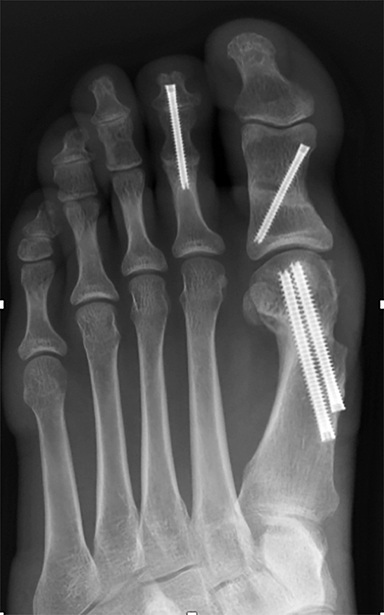
Minimally invasive surgery (MIS) of the foot refers to percutaneous procedures through very small incisions, such as osteotomies using specialized burrs. MIS has been described in the forefoot, midfoot, and hindfoot. Advocates cite faster healing times, decreased pain, earlier weight-bearing, and improved cosmesis as possible benefits. Percutaneous approaches for operative correction of hallux valgus deformity have been reported for more than three decades. The first-generation techniques did not utilize any internal fixation. Those were almost universally abandoned in the United States, as poor correction, nonunion, recurrent deformity, and significant soft-tissue complications were reported. Attempts to improve outcomes with second-generation techniques employing provisional fixation with Kirschner wires were still slow to be embraced, as stability and positioning of the osteotomies were often not ideal.
Although the approach was out of favor in the United States, interest in Europe remained strong, and several successful series have been reported over the past 15 years. Results have been promising, and acceptance of MIS in the United States has slowly increased. Currently, in the United States and abroad, surgeons committing time to attend MIS training courses are now reporting more reproducible outcomes for certain procedures.
Recent improvements in equipment and fixation are considered third-generation techniques and are believed to improve results. A specialized burr allows for low speed (< 10,000 rpm) and high torque. Such systems diminish heat, therefore decreasing the complications of skin and soft-tissue necrosis. Systems with integrated fluid irrigation have been developed to further improve heat dissipation. Surgeons now advocate rigid internal fixation with cannulated screws and documented deformity correction with intraoperative fluoroscopy.


Furthermore, studies are underway to evaluate common procedures that may be amenable to percutaneous osteotomy. MIS osteotomy of the calcaneus appears to have led to successful results with few complications. Other MIS techniques have focused on the forefoot, and techniques are being evaluated for lesser metatarsal osteotomies and bunion procedures. The techniques are technically challenging, and surgeons may find it difficult to reproduce the accuracy of open osteotomies. Precise implant placement is critical to achieve stability while maintaining position. Surgeons must be ready to convert to an open procedure or have a secondary plan if intraoperative difficulties arise. The equipment and techniques are not intuitive, and those interested in performing MIS should seek specialized training, including hands-on cadaver labs, prior to introducing the techniques to their clinical practice.
Clinical Takeaways
- Minimally invasive surgery (MIS) has become more accessible with improved instrumentation.
- Indications and osteotomy location are similar to open surgical methods, as the fundamentals of operative correction have not changed.
- A learning curve is associated with such procedures, and specific MIS training is necessary.
Jorge I. Acevedo, MD, is a member of AAOS and serves on the American Orthopaedic Foot & Ankle Society (AOFAS) Practice Management Committee. He is director of the Foot & Ankle Center for Southeast Orthopedic Specialists in Jacksonville, Fla.
Jesse Doty, MD, is a member of AAOS and serves on the AOFAS Evidence-based Medicine Committee. He is an associate professor at the University of Tennessee and Erlanger Health System in Chattanooga, Tenn.
References
- Dhukaram V, Chapman AP, Upadhyay PK: Minimally invasive forefoot surgery: a cadaveric study. Foot Ankle Int 2012;33:1139-44.
- Kaipel M, Reissig L, Albrecht L, et al: Risk of damaging anatomical structures during minimally invasive hallux valgus correction (Bösch technique): an anatomical study. Foot Ankle Int 2018;39:1355-9.
- Brogan K, Lindisfarne E, Akehurst H, et al: Minimally invasive and open distal chevron osteotomy for mild to moderate hallux valgus. Foot Ankle Int 2016;37:1197-204.
- Frigg A, Zaugg S, Maquieira G, et al: Stiffness and range of motion after minimally invasive chevron-akin and open scarf-akin procedures. Foot Ankle Int 2019;40:515-25.
- Lee M, Walsh J, Smith M, et al: Hallux valgus correction comparing percutaneous chevron/akin (PECA) and open scarf/akin osteotomies. Foot Ankle Int 2017;38:838-46.
- Lai MC, Rikhraj IS, Woo YL, et al: Clinical and radiological outcomes comparing percutaneous chevron-akin osteotomies vs open scarf-akin osteotomies for hallux valgus. Foot Ankle Int 2018;39:311-7.

